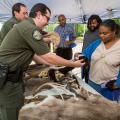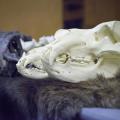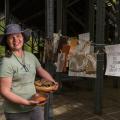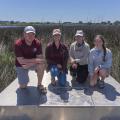Attracting Hummingbirds to Mississippi Gardens
Many Mississippi gardeners enjoy attracting hummingbirds to the landscape. These active birds provide hours of entertainment for children and adults alike and display extraordinary abilities to turn, hover, and fly. The males of these high-octane bundles of energy exhibit beautiful plumage colors of red, pink, bronze, purple, blue, red, and orange. Hummingbirds are unique to the American continents, and 21 species can be found in North America. Only ruby-throated hummingbirds, the most extensive travelers, are known to breed east of the Mississippi river.
Hummingbirds are migratory birds and spend their winters in Central and South America. They return to Mississippi in early spring and leave before the onset of cold weather in fall. Hummingbirds can be easily attracted to visit your garden. These tiny birds like flashy bright colors, and a red plastic feeder will let the birds know where your garden is located. You can purchase commercially-made hummingbird nectar for the feeder, or make your own. Simply mix one part of refined sugar to four parts of water and boil to dissolve the granules. Let the mixture cool and fill the feeder. It is not necessary to add red food coloring to the mixture. It is very important to keep the feeders clean, especially in hot weather, and the mixture should be changed regularly.
While hummingbirds are easily attracted to an area by hanging a plastic nectar feeder, there are other ways of maintaining the needs for hummingbirds in the garden. As with all other birds, hummingbirds should be accommodated for their needs of food, water, shelter, and nesting space.
Food
In addition to sugar water, hummingbirds actually need a variety of food types. Insects are another important source of food, especially during the nesting season. They consume spiders and many types of flying insects. Because of this, it is very important not to use pesticides on plants when providing for the needs of hummingbirds.
It is actually unnecessary to provide sugar water feeders when the correct combinations of flowering plants are added to the garden. When this approach is used, it is important to provide plant types that either flower throughout the growing season, or to use combinations of different plants that will extend nectar sources all year long. The more types of food plants and environments that are added, an increased variety of birds and other animals will be seen. Even if there is little room in the landscape for hummingbird plants, patio containers or hanging baskets are perfectly suitable for attracting these birds.
To attract hummingbirds, it is best to plant a large group of flowering plants rather than a single source. The extra blooms provide more food and are more noticeable. Since these birds are fiercely territorial, provide various locations of plants throughout the landscape.
Hummingbirds typically arrive in Mississippi in March, at the time that red buckeye and native azalea shrubs are in bloom. Hummingbirds are said to follow the bloom time of these plants on their migration north, and these and other spring blooming plants will attract them earlier to your garden. Most hummingbird flowers are tubular in arrangement or shape, scentless, brightly colored, and easy for hummingbirds to hover around. As hummingbirds visit the flowers, the pollen from the male flowers often coat the bird's feathers, and help to pollinate the next flowers visited.
The following is a list of flowering plants that grow in Mississippi which hummingbirds use for food:
Common name |
Scientific name |
Flowering time |
|---|---|---|
ANNUALS |
||
| Begonia | Begonia spp. | Spring, summer, fall |
| Fuschia | Fuschia spp. | Spring |
| Geranium | Pelargonium spp. | Summer |
| Impatiens | Impatiens spp. | Spring, summer |
| Lily | Lilium spp. | Spring |
| Nasturtium | Tropaeolum majus | Spring |
| Petunia | Petunia spp. | Spring, summer |
| Zinnia | Zinnia spp. | Spring, summer |
PERENNIALS |
||
| Bee balm | Monarda spp. | Summer |
| Blazing star | Liatris spp. | Fall |
| Butterfly weed | Asclepias tuberosa | Summer |
| Canna | Canna generalis | Summer |
| Cardinal flower | Lobelia cardinalis | Fall |
| Carpet bugle | Ajuga reptans | Spring |
| Coral bells | Heuchera sanguinea | Spring, summer |
| Four o' clock | Mirabilis jalapa | Summer, fall |
| remove | remove | remove |
| Lantana | Lantana camara | Summer |
| Penstemon | Penstemon spp. | Spring |
| Phlox | Phlox spp. | Spring |
| Salvia | Salvia spp. | Summer, fall |
| Dianthus | Dianthus spp. | Spring |
| Verbena | Verbena spp. | Spring, summer |
SHRUBS |
||
| Century plant | Agave americana | Rarely blooms |
| Althea | Hibiscus syriacus | Summer |
| Yucca | Yucca spp. | Summer |
| Abelia | Abelia grandiflora | Spring, summer |
| Azaleas | Rhododendron spp. | Spring |
| Honeysuckle | Lonicera spp. | Spring |
| Weigela | Aesculus pavia | Spring |
VINES |
||
| Cypress vine | Ipomea quamoclit | Summer, fall |
| Morning glory | Ipomea spp. | Summer |
| Trumpet creeper | Campsis radicans | Spring |
| Coral honeysuckle | Lonicera sempervirens | Spring, summer |
TREES |
||
| Coralbean | Erythrina crista-galli | Summer |
| Crabapple | Malus spp. | Spring |
| Hawthorne | Crataegus spp. | Spring |
| Locust | Robinia spp. | Spring |
| Tulip poplar | Liriodendron tulipifera | Spring |
Water
Water is an important factor for hummingbirds, as much as eight times their body weight is taken in per day! They will use any source of water but usually avoid landing on the ground, and prefer safe water sources. Typically they avoid deep water as in a birdbath, but can be used by the addition of a few rocks or bricks to decrease depth.
A great source of water, especially in the summer, is with the addition of a mister. This small hose attachment shoots a fine spray or mist into the air. Hummers will fly through the mist to cool down on hot days, or will drink from it.
Shelter
A variety of landscape spaces appeals to hummingbirds and other birds. Open sunny areas, partial shade areas, and dense shade will provide opportunities for birds to either cool down or warm up. Groups of shrubs and trees will allow birds to perch and survey their territories or favorite plants, as well as keep an eye out for predators. The birds spend about four-fifths of each day perching quietly in trees or shrubs. Males will usually perch anywhere in the open, while the females tend to perch in protected areas of shrubs or trees.
Nesting space
Hummingbirds usually use vines, shrubs or trees as nesting sites. The nest is most often attached to a branch or in the crotch of a forked limb. Plant fibers, fluffy seeds, lichens, and spider webs are used to construct the tiny nest. Leave plenty of these items available in your yard throughout the year. Allow undisturbed areas of your yard to grow with thickets of trees, shrubs, and vines to provide for nesting space. Birds will not nest in high traffic areas.
These factsheets were written by Robert F. Brzuszek, Assistant Extension Professor, The Department of Landscape Architecture, Mississippi State University.
Publications
News
An underserved community spent a day enjoying the outdoors at the Sam D. Hamilton Noxubee National Wildlife Refuge in early May as Mississippi State University Extension Service personnel hosted 20 adult residents of care homes.
Jim McAdory, MSU Extension agent in Winston County, coordinated the May 1 event with help from several other Extension agents and U.S. Fish and Wildlife Service staff. The goal was to allow this population to experience the outdoors, complete with a hot dog lunch at the end of the event.
PICAYUNE, Miss. -- School groups, nature enthusiasts and the public can enjoy two fun-filled days of exciting, hands-on learning about the environment, ecosystems, wildlife and insects at the Mississippi State University Crosby Arboretum in Picayune. BugFest offers insect-related displays, interactive exhibits, games and crafts. Biologists, naturalists, entomologists and other experts from Mississippi, Louisiana and Alabama will host booths and give presentations on butterflies, bats, caterpillars, beetles, crayfish, ladybugs, hissing cockroaches, dancing praying mantises, native and exotic arthropods and more.
Two conservation camps this summer offer students in grades six through 12 the opportunity to gain hands-on experience in wildlife science, outdoor recreation and conservation careers. Conservation Camp 2022 has a residential edition June 5-8 for rising eighth through 12th graders. The day camp edition is June 13-15 for rising sixth through eighth graders.
Success Stories
More than 80 grade-school students from Choctaw Tribal Schools visited Mississippi State University in March to participate in Choctaw Preview Day.
Robin Whitfield, who gave the child the paper, stands awestruck, watching her friend’s daughter use the flower to draw and color on the page.
Mississippi State University and partners have been awarded a grant of nearly $6.6 million from the National Fish and Wildlife Federation for shoreline restoration work on the Gulf Coast.




